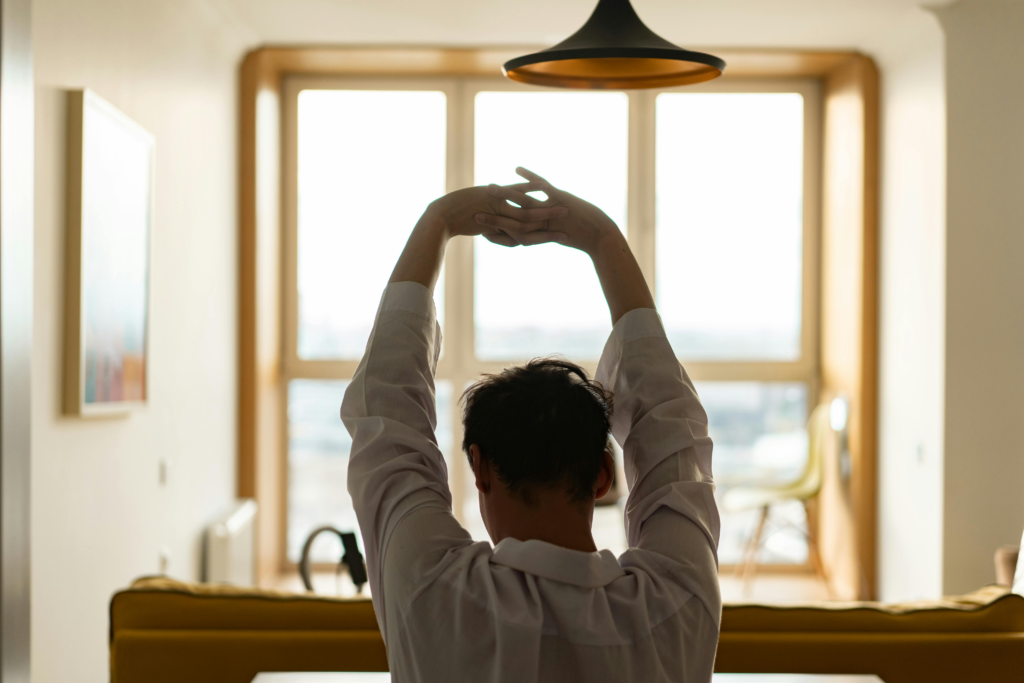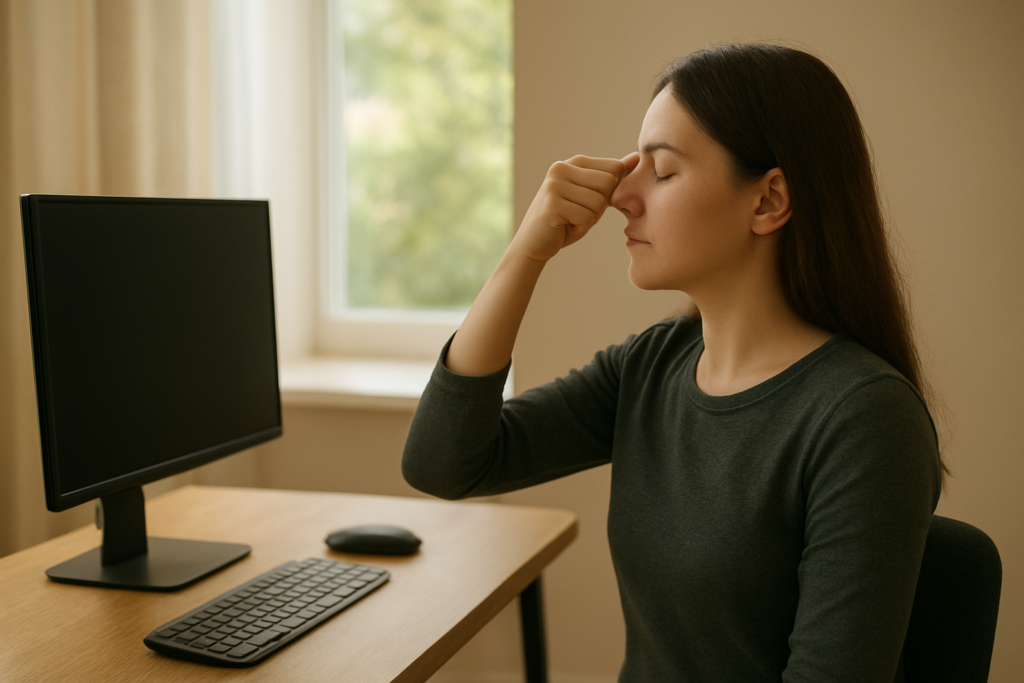🌅 Introduction: Why Your Eyes Need a Digital Routine
Our eyes were never designed to stare at glowing screens for 8+ hours a day. Yet in 2025, the average adult spends more than 11 hours daily looking at digital devices. This constant exposure to blue light, flickering pixels, and artificial brightness leads to a modern epidemic known as Digital Eye Strain (DES) — with symptoms like dry eyes, blurry vision, headaches, neck pain, and fatigue.
The good news? You can protect and even strengthen your eyes by creating a simple, structured daily routine that supports your vision from morning to night.
This guide walks you through a science-backed daily plan to reduce eye strain, improve focus, and enhance long-term visual wellness — perfect for anyone working with computers, tablets, or smartphones.
🕕 Morning Routine: Prepare Your Eyes for the Digital Day
1. Start Your Day with Natural Light
Before checking your phone, spend a few minutes near a window or go for a short walk.
Morning sunlight helps regulate your circadian rhythm and boosts serotonin, improving mood and reducing eye fatigue later in the day.
2. Hydrate First Thing
Dehydration contributes to dry eyes. Drink a full glass of water upon waking to kickstart tear production and hydration.
3. Morning Eye Warm-Up (2 minutes)
Do gentle eye yoga:
- Roll your eyes clockwise and counterclockwise.
- Look left-right, up-down slowly.
- Blink rapidly 10–15 times to activate tear glands.
4. Nutrition for Focus & Eye Protection
Include antioxidant-rich foods in your breakfast — blueberries, spinach, eggs, salmon, or chia seeds.
These provide lutein, zeaxanthin, and omega-3 fatty acids, vital for retinal health and reducing oxidative stress.

💻 Midday Routine: Protect Your Eyes While You Work
Most eye strain occurs during work hours. Building small protective habits can make all the difference.
1. The 20-20-20 Rule
Every 20 minutes, look at something 20 feet away for 20 seconds.
Set a timer or use free apps like EyeCare or Stretchly to remind you.
2. Optimize Your Workspace
- Position your monitor 50–70 cm (20–28 inches) from your eyes.
- Keep the top of the screen at or slightly below eye level.
- Adjust lighting to avoid glare.
- Use a matte screen filter or anti-glare glasses.
3. Blink Training
Blink consciously every few seconds to maintain a healthy tear film.
If you notice dryness, use preservative-free artificial tears.
4. Incorporate Eye-Friendly Breaks
Every 1–2 hours, stand up and stretch. Focus on distant objects outside your window to relax the ciliary muscles.
5. Nutrition Boost: Midday Snacks
Eat foods rich in vitamin C and zinc, such as citrus, nuts, and pumpkin seeds.
These support retinal health and prevent oxidative damage from screen light.

🌇 Evening Routine: Recover and Reset Your Vision
After sunset, your body and eyes begin preparing for rest. But artificial light and screens can disrupt this process.
1. Reduce Blue Light Exposure
- Turn on Night Mode or Blue Light Filters on all your devices after 7 PM.
- Wear blue light blocking glasses if working late.
- Dim room lights to a warm tone.
2. Eye Relaxation Ritual (5 minutes)
Try palming — rub your hands together and cup them gently over your closed eyes.
This relaxes the optic nerves and promotes circulation.
Alternative: Do focus shifts — look at your finger 10 inches away, then at a distant object. Repeat 10 times.
3. Evening Nutrition
Include foods like sweet potatoes, kale, and fish rich in omega-3s to support night vision and tear film health.
4. Screen Curfew
Stop using screens at least 45 minutes before bed.
Instead, listen to relaxing music, journal, or do light stretching.
🧘♀️ Eye Exercises for Daily Routine
Incorporate these short, effective exercises:
- Blinking Exercise – 15 rapid blinks every hour.
- Focus Shift – Alternate focus between near and far objects.
- Figure 8 Exercise – Move your eyes in a horizontal figure 8 pattern slowly.
- Eye Massage – Gently massage the area around your eyes with clean fingers.
Doing this for just 5 minutes twice a day helps reduce tension, dryness, and fatigue.
🧴 Skincare and Eye Hygiene
Digital work can make you rub your eyes more often, increasing irritation.
- Wash your hands before touching your eyes.
- Remove makeup thoroughly.
- Use cool compresses to relieve puffiness.
- Clean your screen daily — dust and glare worsen strain.
⚙️ Technology Tips to Support Eye Health
- Adjust Brightness: Match screen brightness to your surroundings.
- Use Anti-Reflective Coatings on your glasses.
- Increase Text Size: Larger fonts reduce focus effort.
- Eye-Care Apps: Try EyeLeo or CareUEyes for reminders and exercises.
🌿 Supplements That Support Digital Eye Health
If your diet is lacking, consider these scientifically backed supplements:
- Lutein & Zeaxanthin – Natural filters for blue light.
- Omega-3 Fatty Acids – Maintain tear film quality.
- Vitamin C & E – Reduce oxidative stress.
- Zinc – Supports retinal enzyme function.
(Always consult your optometrist before starting supplements.)
❓ FAQ Section
Q1: How many hours of screen time are safe daily?
There’s no universal number, but experts suggest taking breaks every 20 minutes and limiting non-work screen time to under 2 hours.
Q2: Can blue light glasses really prevent eye strain?
They can reduce glare and improve comfort, especially in low-light or nighttime use.
Q3: Is digital eye strain reversible?
Yes — symptoms improve with regular breaks, hydration, and proper workspace setup.
Q4: Do eye exercises improve vision permanently?
They don’t correct refractive errors but strengthen focusing muscles and reduce fatigue.
Q5: Should I use artificial tears daily?
If you experience dryness, yes — use preservative-free drops to maintain comfort.
✅ Conclusion
Creating a daily routine for digital eye health is about small, consistent actions.
With the right balance of light exposure, hydration, nutrition, ergonomics, and rest, your eyes can adapt to the digital world without sacrificing comfort or clarity.
Your digital habits directly shape your vision future — so start today with intentional care and smart visual hygiene.



